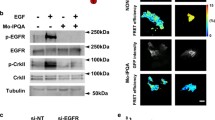Abstract
A tamoxifen-resistant cell line (MCF7TAM) was established from tamoxifen-sensitive MCF-7 human breast cancer cells expressing estrogen receptors. Though the resistant cell line grows in the presence of tamoxifen, estrogen receptors continue to be expressed at similar levels as in the parental cell line. However, estrogen receptors appeared to be altered in the resistant cell line since important discrepancies are observed between results obtained with ligand binding assays and immunoenzymatic assays, tending to show modifications of estrogen receptor ligand binding capacity. The intracellular distribution of tamoxifen in sensitive and resistant cell lines was investigated using fluorescence of eosin–tamoxifen ionic association. Fluorescence emission spectra of eosin, tamoxifen and eosin–tamoxifen complex (λex = 480 nm) were analyzed and the maximal fluorescence intensity found for the complex (λem = 540 nm) was four times higher than that of eosin alone, while tamoxifen alone did not emit any fluorescence in this spectral range. In MCF-7 cells, tamoxifen was found to be mainly located surrounding the nucleus, although nuclear fluorescence intensity was significantly lower. No highly fluorescent granules were observed in the resistant cell lines as opposed to sensitive cells. Improvement of this fluorescence microscopy methodology could appear of interest, taking into account the complexity of tamoxifen resistance molecular pathways.
Similar content being viewed by others
References
Bachmann-Moisson N, Barberi-Heyob M, Merlin JL. Molecular mechanisms of tamoxifen resistance. Bull Cancer. 1997; 84:69–75.
Bartoli MH, Rochat J, Beriel H, Mouriquand J. Tamoxifen induced fluorescence as a marker of hormone responsiveness: physicochemical data. In: CR Acad Sci Paris. 1982 (Oct. 4th); t. 295.
Berthois Y, Katzenellenbogen JA, Katzenellenbogen BS. Phenol red in tissue culture media is a weak estrogen: implication concerning the study of estrogen-responsive cells in culture. Proc Natl Acad Sci USA. 1986;83:2496–500.
Brogniez AP, Mordon SR, Devoisselle JM, Farre I, Querleu D, Brunetaud JM. Fluorescence of experimental endometriosis in rabbits, using tamoxifen-eosin association. Hum Reprod. 1995;10:927–31.
Clarke R, Lippman ME. Acquisition of antiestrogen resistance in breast cancer. In: Teicher BA, ed. Drug resistance in oncology. New York: Marcel Dekker; 1993:501–36.
Daffada AAI, Johnston SRD, Smith IE, Detre S, King N, Dowsett M. Exon 5 deletion variant estrogen receptor messenger RNA expression in relation to tamoxifen resistance and progesterone receptor/pS2 status in human breast cancer. Cancer Res. 1995;55:288–93.
EBCTCG (Early Breast Cancer Trialists Collaborative Group). Systemic treatment of early breast cancer by hormonal cytotoxic, or immune therapy. Lancet. 1992;330:1–15, 71-85.
EORTC (European Organization for Research and Treatment of Cancer) Breast Co-operative Group. Revision of the standards for the assessment of hormone receptors in human breast cancer. Eur J Cancer. 1980;16:1513–5.
Fuqua SAW, Wolf DM. Molecular aspects of estrogen receptor variants in breast cancer. Breast Cancer Res Treat. 1995;35: 233–41.
Fuqua SAW, Fitzgerald SD, Chamness GC. Variant human breast tumor estrogen receptor with constitutive transcriptional activity. Cancer Res. 1991;51:105–9.
Jordan VC, Wolf MF, Mirecki DM. Hormone receptors assays: clinical usefulness in the management of the carcinoma of the breast. Crit Rev Clin Lab Sci. 1988;26:97–152.
Lykkesfeldt AE. Growth regulation of human breast cancer cells by estrogens and antiestrogens. University of Copenhagen. Thesis, 1997.
Marchal S, Marchal C, Hoffstetter S, Parache RM, Pernot M. Determination of estrogen and progesterone receptors in endometrial adenocarcinomas. Comparison between dextran-coated charcoal and immunoenzymatic methods on curettage biopsies. Anticancer Res. 1992;12:1307–10.
Mouriquand J, Mouriquand C, Petitpas E, Louis J, Mermet MA. Differential nucleolar staining affinity with a modified Papanicolaou staining procedure. Stain Technol. 1981;56: 215–9.
Mouriquand J, Jacrot M, Louis J et al. Tamoxifen-induced fluorescence as a marker of human breast tumor cell responsiveness to hormonal manipulations: correlation with progesterone receptor content and ultrastructural alterations. Cancer Res. 1983;43:3948–54.
Nicholson RI, Syne JS, Daniel CP, Griffiths K. The binding of tamoxifen to oestrogen receptor proteins under equilibrium and non-equilibrium conditions. Eur J Cancer. 1979;15: 317–29.
Osborne CK, Fuqua SAW. Mechanisms of tamoxifen resistance. Br Cancer Res Treat. 1994;32:49–55.
Pavlik EJ, Nelson K, Srinivasan S et al. Resistance to tamoxifen with persisting sensitivity to estrogen: possible mediation by excessive antiestrogen binding site activity. Cancer Res. 1992;52:4106–12.
Schneider E, Horton JK, Yang CH, Nakagawa M, Cowan KH. Multidrug resistance-associated protein gene overexpression and reduced drug sensitivity of topoisomerase II in human breast carcinoma MCF7 cell line selected for etoposide resistance. Cancer Res. 1994;54:152–8.
Tonetti DA, Jordan VC. Possible mechanisms in the emergence of tamoxifen-resistant breast tumor. Anti-Cancer Drugs. 1995;6:498–507.
Author information
Authors and Affiliations
Rights and permissions
About this article
Cite this article
Bachmann, N., Barberi-Heyob, M., Bour, C. et al. Intracellular distribution of tamoxifen in resistant human breast adenocarcinoma cells using tamoxifen–eosin association. Cell Biol Toxicol 14, 429–435 (1998). https://doi.org/10.1023/A:1007555929901
Issue Date:
DOI: https://doi.org/10.1023/A:1007555929901




